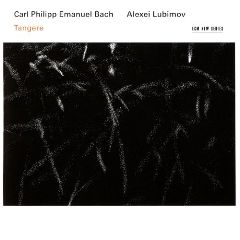Carl Philipp Emanuel Bach - Tangere (2017)
Carl Philipp Emanuel Bach - Tangere (2017)

1 Freye Fantasie fis-Moll Wq 67 11:14 Sonate II d-Moll Wq 57 (3. Sammlung, 1781) 2 Allegro Moderato 6:20 3 Cantabile E Mesto 3:17 4 Allegro 2:32
5 Rondo II c-Moll Wq 59/4 (5. Sammlung, 1785) 5:15 6 Fantasie d-Moll Wq 117/12 0:28 7 Fantasie G-Dur Wq 117/11 0:34 8 Fantasie D-Dur Wq 117/8 0:32 9 Fantasie B-Dur Wq 112/8 1:02 Clavierstück Für Die Rechte Oder Linke Hand Allein A-Dur Wq 117/1 10 I 1:31 11 II 1:04
12 Solfeggio C-Dur Wq 112/10 0:54 13 Solfeggio A-Dur Wq 117/4 0:31 14 Solfeggio Es-Dur Wq 117/3 0:48 15 Solfeggio c-Moll Wq 117/2 0:54 16 Solfeggio d-Moll Wq 64/1 (6. Sammlung, 1787) 4:34 Sonate VI G-Dur Wq 55 (1. Sammlung, 1779) 17 Allegro Moderato 8:16 18 Andante 3:29 19 Allegro Di Molto 6:12
20 Fantasie II C-Dur Wq 59/6 (5. Sammlung) 7:27 Alexei Lubimov - Piano, Tangent Piano
Are you ready for extreme 18th century keyboard? The typically sparse packaging graphics of this ECM release may indicate only to German speakers what's contained inside: a "Tangentenflügel" is a tangent piano, a rare keyboard instrument of Mozart's time that used hammers, striking the strings at a tangent, but no dampers. The sound combines qualities of a clavichord (its nearest relative, but the tangent piano is louder), a fortepiano, and a harpsichord. Occasional recordings using the instrument exist, but this one by Russian keyboardist Alexei Lubimov may be the first one to really show what it can do. Lubimov states that the tangent piano is especially well suited to the music of Carl Philipp Emanuel Bach, with its "affects, diversity of rhetoric, melancholy humor, paradoxical harmonic effects, idiosyncratic rhythms." There's no evidence that these particular pieces were played on a tangent piano, but Bach is known to have had access to one at the court of Frederick the Great, and the results here are nothing short of spectacular. You could start with the Freye Fantasie in F sharp minor Wq 67, where Lubimov lays out most of the instrument's capabilities of dynamic and coloristic contrast. The two keyboard sonatas included are hardly less extreme in their musical language or in the interpretation here. Elsewhere, Lubimov offers some pretty obscure pieces: a two-movement, one-handed piano work, some short pieces called Fantasie or Solfeggio that consist of single little rhetorical gestures and last between 30 seconds and a minute each, two energetic rondos, and a second full-length fantasy for a rousing conclusion. Whether or not this reading is historically "accurate," Lubimov seems to achieve a kind of insight into the mind of this notoriously troublesome composer that no one else has quite managed before, and the end result is often gripping. ---James Manheim, AllMusic Review
Russian pianist Alexei Lubimov is the rare artist who has been a trailblazer in two directions, both a champion of new music and a dedicated interpreter of Baroque music with a passion for period instruments. In this remarkable reading of music by CPE Bach, Lubimov responds to the inventiveness of the composer’s fantasies, sonatas and rondos by making full creative use of the sonorities of the tangent piano with great expression and intensity. ---arkivmusic.com
download (mp3 @320 kbs):
yandex 4shared mega mediafire uloz.to cloudmailru gett








